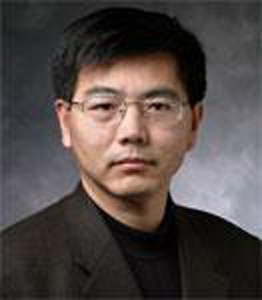Program Information
Nanotechnology & Molecular Imaging
L Xing1*, G Pratx2*, S Chang3*, B Pogue4*, (1) Stanford Univ School of Medicine, Stanford, CA, (2) Stanford University, Stanford, CA, (3) University of North Carolina, Chapel Hill, NC, (4) Dartmouth College, Hanover, NH
TH-E-103-1 Thursday 1:00PM - 2:50PM Room: 103Pushing PET Imaging to the Cellular Level: Development of a Radioluminescence Microscope - Guillem Pratx, PhD
Molecular imaging with radionuclide probes provides sensitive, quantitative, and non-invasive characterization of molecular disease processes in vivo at a macroscopic scale. However, current imaging technology lacks the ability to visualize the tremendous heterogeneity exhibited by biological processes at the single-cell level. Little is known about the factors that modulate radiotracer uptake by single cells and explain observed cell-to-cell variation.
The radioluminescence microscope has been developed as a new tool for the visualization of radiotracer uptake in single living cells. It provides a means to probe the dynamic of small-molecule uptake with high spatial and temporal resolution, in a fluorescence microscopy environment. Two image acquisition schemes are presented: an analog acquisition mode for acquiring images quickly with little post-processing, and a digital acquisition mode for precise quantitation of radiotracer concentration in individual cells.
Several applications of this new imaging method will be presented, including imaging of dynamic FDG uptake in single cells, imaging of frozen tissue sections, and imaging of FDG uptake by single circulating tumor cells.
Learning Objectives:
1. Understand the limitations of current radionuclide imaging technology
2. Understand image formation in radioluminescence microscopy
3. Discover applications of radioluminescence microscopy
Carbon Nanotubes Field Emission X-ray Technologies for Research and Clinical Application in Radiation Oncology - Sha X. Chang
Carbon nanotubes (CNT) field emission is a unique type of nanotechnology that has opened up new horizons for medical imaging and radiation therapy device technologies. The major advantages of the CNT field mission based x-ray technologies over the conventional thermionic emission x-ray technology are ultra-high temporal resolution and flexibility in distributed x-ray source design. The latter is deal for customizing cathode and thus the x-ray tube design for each specific application. For instance, instead of a single point x-ray source that rotates relative to the patient for tomosynthesis imaging a novel x-ray tube with an array of individually addressable x-ray pixel sources can acquire the image significantly faster and without tube rotation. The benefit in this case is higher patient comfort and less motion distortion for breast tomosynthesis imaging; for IGRT application the advantage is real-time 3D image guidance without interfering with treatment delivery.
For the last decade and in collaboration with industry partners the multidisciplinary CNT x-ray technology and application development team at University of North Carolina has developed several novel imaging and irradiation devices and demonstrated their feasibilities. These CNT field emission devices include ultra-high temporal resolution micro-CT capable of cardiac motion gated CT for small animals, multi-pixel x-ray stationary breast tomosynthesis (in clinical trial now), multi-pixel x-ray source array for stationary onboard tomosynthesis imaging for IGRT, electron microbeam cellular irradiator capable of 1000 Gy/sec, and compact microbeam radiation therapy device with image-guidance and gating for preclinical research. These novel imaging and therapy technologies have stimulated new radiobiology research activities and innovative approaches for clinical imaging and therapy.
Learning Objectives:
1. Understand the principle of carbon nanotube field emission x-ray technology
2. Understand that ultra-high temporal resolution and flexibility in distributed source design are two major advantages of this new x-ray technology
3. Understand that carbon nanotube field emission x-ray technology has opened up new horizons for novel imaging and therapy device development.
Imaging Cerenkov emission for visualizing dose and sensing oxygenation - Brian W. Pogue
Cerenkov emission occurs from all matter during radiation therapy, and for energies above a threshold value, the emission intensity is proportional to the deposited dose. This proportionality holds within most energy beams, because the photon collisional energy transfer and Cerenkov emission do not have a strong energy dependence above 0.5 MeV. Imaging of dose in water and in tissue phantoms shows this proportionality. This has been validated by direct comparison with ionization chamber measurements and Monte Carlo modeling. The Cerenkov image acquisition can be triggered by the 5 microsecond LINAC pulses at 180Hz, allowing capture the Cerenkov emission as blue light coming from the phantoms/tissue, during normal ambient room lighting.
Three dimensional tomography of beam profiles in water tanks has been demonstrated with multiple angle imaging of the beam, using cone-beam computed tomography recovery. The recovery of full 3D images requires minutes of acquisition, as compared to multiple hours of acquisition with an automated ionization chamber.
Surface imaging for in vivo dose mapping has been able to be imaged, and the value of these images may be in tracking skin dose, which is well known to be inaccurately predicted by treatment planning systems for complex tissue shapes. Whole breast irradiation is standard of care management following breast conserving surgery to remove localized cancer. Preliminary results from this phase 1 clinical trial can be presented.
The theoretical underpinnings will be reviewed along with experimental studies in the development pipeline of this new technology.
Learning Objectives:
1. Understand the relationship between Cerenkov emission and dose deposition
2. Understand the camera systems and signal levels achievable.
3. Understand the relative potential for fast 3D beam profile imaging in water tanks.
4. Understand the potential for skin dose imaging.
Making X-ray Imaging a Molecular Imaging Modality - Lei Xing
Novel dual modality of X-ray CT and molecular optical imaging techniques using X-ray activatable targeted nanoparticles, X-ray luminescence computed tomography (XLCT) and X-ray fluorescence computed tomography (XFCT), are reported. XLCT uses X-ray as a single source to image tissues and to excite molecular probes simultaneously, thus providing anatomic and molecular information together. With XLCT, the nanoparticle based molecular probe will emit near-infrared (NIR) light when it is irradiated with X-ray, thereby, seamlessly integrating X-raystructural imaging and molecular optical imaging. This synergistic approach will provide significant advantages that would otherwise be impossible with current sole-optical or X-ray CT techniques. Specifically, these include: (1) it can produce anatomic and molecular images that are spatially and temporally registered; (2) the spatial resolution of the images can be made arbitrarily small by narrowing the beam and increasing the sampling rate. Similarly, the signal strength--and, therefore, the molecular sensitivity--increases with beam current; (3) compared to other modalities, few physical factors degrade the image quality (e.g., there is no background autofluorescent signal during X-ray excitation of the molecular probes); 4) for traditional NIR fluorescence imaging, light used as an illumination source has low tissue penetration ability and thus generally finds difficulties exciting molecular probes in deep tissues. To the contrary, X-ray has excellent tissue penetration ability and can excite nanoparticles localized anywhere in the body to produce NIR light. This property is helpful for deep tissue imaging; Moreover, for XLCT, spatial information of the photons produced by nanoparticles is obtained from X-ray spatial encoding instead of from the NIR imaging system, which further improve the deep tissue imaging ability of XLCT; and (5) XLCT could produce high-quality images because X-rays have minimum scattering in tissues and spatially-selective excitation could be applied. The spatial resolution of an XLCT scan is dictated by the collimator and the sampling rate and it is possible to achieve the highest spatial resolution. XFCT is similar to XLCT in principle but the source of signal arises from the Kα emission of high-Z contrast agent, instead of optical signal.
Learning Objectives:
1. Gain knowledge on X-ray fluorescence and luminescence
2. Understand the fundamental principles of XLCT and XFCT.
3. Learn image reconstruction techniques for XLCT and XFCT.
4. Enhance knowledge in nanomedicine and molecular imaging.
Contact Email:









